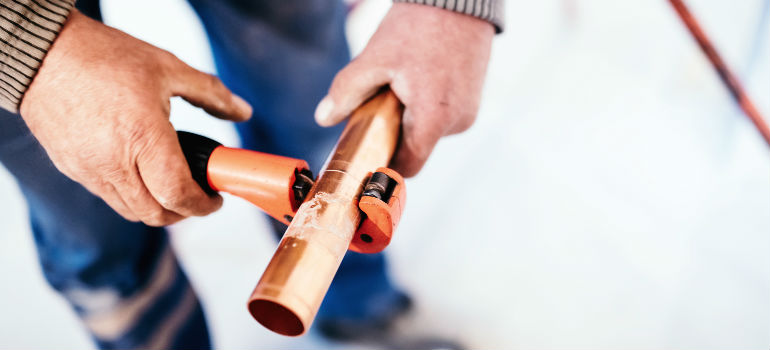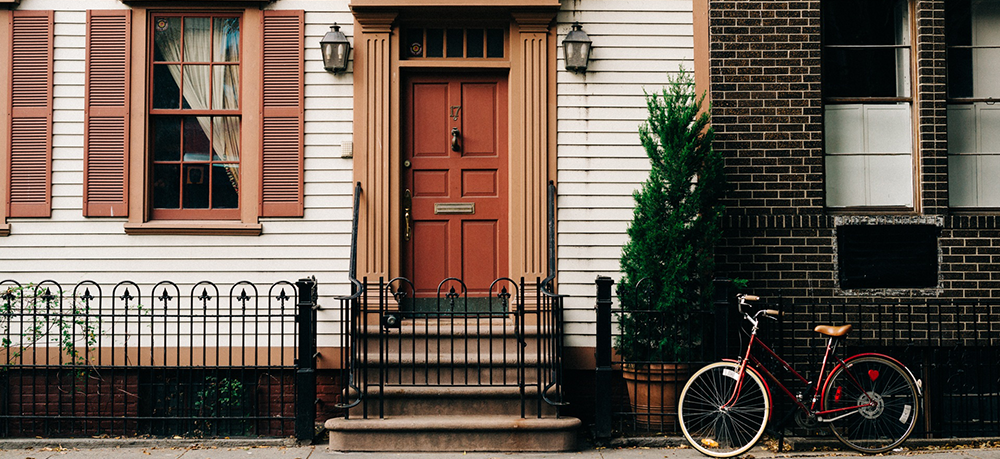
Broken pipes spell a world of trouble for every homeowner. Fortunately, they can be fixed, and the causes for their damage – prevented.
With the right tools, skills, and knowledge of your home’s blueprint, you too could do the job.
Table of Contents
What Causes Pipes to Break?
Very cold weather is the leading cause of bursting pipes. It causes the water inside them to expand and get close to freezing. When the pressure increases too much, the structure of the pipe gets damaged. This usually happens when the temperature goes down to -6 degrees C.
How Do You Know if a Pipe Has Burst
The signs of a burst pipe can often go unnoticed or they can be all over the place, depending on the spot and magnitude of the rupture. The signs will always include water.
- Flooding. The most obvious sign – if you notice puddles of water on the floor, if the walls are very wet, and if you see the water meter spinning like crazy, then you have a flood.
- Bubbling walls. When the water leakage is not that obvious, you can notice bubbles forming under the paint or wallpapers of your walls.
- Mould. Another sign for too much moisture. Some homes have this problem regardless, but if you’re experiencing mould for the first time in a while, the reason might be a broken pipe.
- Patches of extra green grass. If a pipe has burst outside your home and around your yard, water would be flooding on your lawn. And if there are patches of very green grass, it’s probably a damaged pipe.
In any case, it’s best to immediately call a professional plumber. Make sure to do quick research to find the reliable plumbers near you and avoid rouge “experts” on your way. Or, if you have the necessary knowledge – start fixing the problem right away.
Need a Handyman?
Enter your postcode to view our rates and availability in your area.
For questions about the services we offer visit our main site or you can always call us at 020 3404 4045
How to Locate the Broken Pipe
When ice forms inside your pipes, it doesn’t necessarily damage the spot where it formed. Sometimes, all the ice does is create a blockage, building pressure that will erupt at the most vulnerable spot, which may be found somewhere else. That’s why it’s very important to locate the exact place of the breakage.
- Examine the water damage signs. Look-over your walls, floor, ceiling, basement and stop on the spot where the signs of damage are most noticeable. Your leak is most probably there, though it’s not necessary. Very often water pools on a different spot.
- Search exposed basement pipes for corrosion and mould. Corrosion, moisture, mould, or rotted wood indicate the need of leak repair nearby. The broken pipe is most likely located behind the wall.
- Try to scent the smell of sewage. Well, you don’t really need to try for this one. Sewage smell indicates that not only do you have a broken pipe, but it’s also a sewer pipe. And, for this one, things can get very messy. It’s recommended that you immediately call a professional as they have specialised equipment to deal with such cases. Not only that, but the toxic gas from the sewer pipes is highly explosive.
Leaky boiler? Check our guide on how to fix a leaky boiler pipe here.
How to Fix a Broken Pipe Inside a Wall
Fixing a pipe inside a wall is no easy task, so it’s a lot better to let a professional plumber deal with this. But if you feel confident you can do it yourself, just follow these instructions.
- Cut out sections of the damaged drywall with a saw. Once you are completely sure where the damage is located, cut the wall in order to have access.
- Wrap a sheet around the pipe and move around until it gets wet. If you don’t have the luck to see the breakage with your own eyes, you’ll need to find it with a sheet of cloth. You may have to repeat this a few times until you pinpoint the exact place of the breakage.
- Place a container under the broken pipe. The plumbing repair will be messy, so the container should catch anything that spills from the pipe you’re about to work on.
- Cut the pipe below the leak. You need to use a pipe cutter tool for this. Screw the tool tightly and rotate until the pipe is cut through.
- Dry the pipe. You can’t work if it’s wet.
- Cut above the leak with a pipe cutter again.
- Clean the pipe. This includes both the inside and outside. The inside might hold more ice, so make sure it’s clear from any obstructions.
- Mount a copper repair sleeve. Use a blowtorch to heat the bottom end of the repair sleeve. Allow the solder to melt and fill the joint. After it cools in about 10 minutes, do the same for the upper end. Wear safety goggles and gloves when doing this. Check for leaks after you’re done.
- Patch the wall.
Check also:
How to Prevent Pipes from Freezing
If you value your house, you have to pay a lot of attention to the plumbing. If you prefer not to call a plumber every winter, you need to take preventive measures against low temperatures.
- Insulate all water pipes. Insulation is the first step to prevent freezing, but it’s not the only thing you need to do, as it only slows down the cold air.
- Use heating devices. If you had to deal with broken pipes in the past, then you already know where the most problematic spots are. If they happen to be in your basement or in another room, then simply heat the room. It might not do good for your electric bills, but it’s going to keep the pipes from bursting.
- Heat the area around the frozen part manually. If you prefer not to heat the entire room, you can simply monitor the temperature and do something about it only when it gets too cold. Schedule frequent visits to your pipes and heat them up if you notice any signs of ice.
- Use a temperature-controlled thermal convection powered hot water recirculation valve. This one does not need electricity to work. What it does is circulate warm water through the hot and cold water lines when the temperature falls below a certain point. The downside of this method is the fact that it requires the valve to be installed two or three floors above the water heater. Also, your water bill will go up noticeably.
Maintaining your home’s pipes in cold weather is a very responsible task and, in most cases, your expertise may not be enough. That’s why it’s best to make a full inspection every year and catch the problems before they occurred.
Header Photo source: bogdanhoda/shutterstock.com



